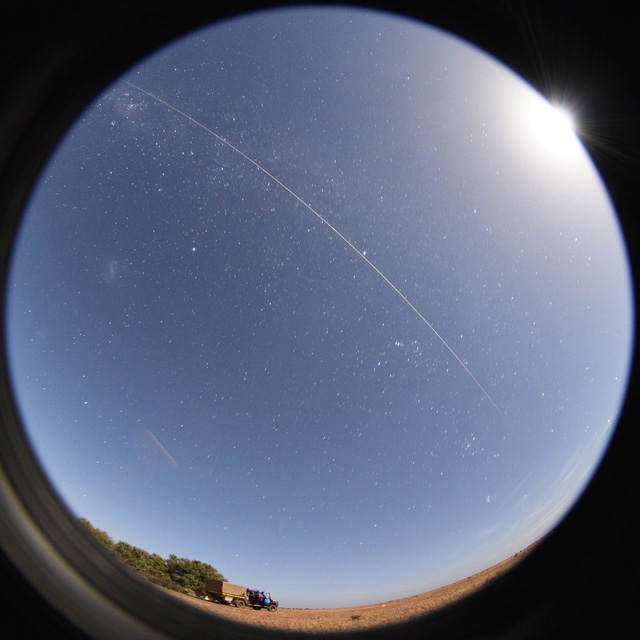23 July 2025—The seismic signature of a fireball meteoroid event can be used to tell whether the fireball fragmented or remained intact as it fell through the atmosphere, according to new research published in Seismological Research Letters.
The 2020 return of the sample capsule from the asteroid-exploring Hayabusa2 mission to southern Australia offered a unique opportunity to test this idea, write Iona Clemente at Curtin University and colleagues in the journal.
Clemente and colleagues compared seismic signals associated with the Hayabusa2 capsule’s return with signals collected from two natural meteoroids and the re-entry of the upper stage of a 2.5-ton Russian Soyuz 2.1b rocket that all plummeted to Earth over Australia.
The researchers concluded that objects that remained intact during their fall—Hayabusa2, the Soyuz re-entry and one of the natural meteoroids—had a distinct seismic signature compared to a large natural meteoroid over North Queensland that likely fragmented with a final dramatic airburst or disintegration.
Visual evidence of fireball fragmentation is rare, making it important to have another way to identify these events, said Clemente. “Understanding fragmentation helps us model how different types of space objects might behave during atmospheric entry, informing planetary defense strategies.”
For instance, shock waves produced solely by the high-speed trajectory of the object through the atmosphere will radiate energy mostly in one direction, compared to shock waves produced by fragmentation, which will radiate energy in all directions, she explained. Fragmentation data chelps researchers refine their estimates of where meteoroids fall and how large a debris field they create.
Fragmentation can also provide valuable information on the composition of a meteoroid’s parent body, as chondritic or stony meteoroids are usually weaker and more prone to fragmentation compared to iron-rich meteoroids. “This distinction helps build statistics on the types of objects entering Earth’s atmosphere and improves our understanding of the relative proportions of chondritic versus iron-type meteoroids,” Clemente noted.
Shock waves produced by fireball events are captured as seismic or acoustic waves on the ground. In the SRL study, the researchers used seismic data captured by both permanent seismic networks in Australia and two temporary high-density seismic networks that operated from 2018 to 2022 and 2020 to 2022.

Knowing exactly when and where the Hayabusa2 sample capsule was to return to Earth, the researchers could zero in on traces in the seismic record to characterize and verify the capsule’s unique re-entry signature. They confirmed that the shock wave produced by the capsule came from its ballistic trajectory, or its high-speed trajectory through the atmosphere.
“The strong observed signal for the Hayabusa2 [capsule] is largely due to the dense seismic network that happened to be positioned directly beneath the re-entry trajectory,” Clemente explained. “This level of station coverage is rare and enabled us to capture the ballistic shock wave signature with good clarity and a high signal-to-noise ratio.”
The strong similarity in signals between the Hayabusa2 capsule and a 2021 fireball that fell over Lake Torrens, South Australia “was also particularly interesting,” she added. “The strong match we get between the two events likely indicated that this object didn’t fragment. This is supported by the data we have from the Desert Fireball Network, which uses the brightness of the object—light curves—to identify fragmentation.”
Curtin University’s Desert Fireball Network is an Australian network of cameras that tracks meteoroids entering the atmosphere.
The researchers note that variations in atmospheric temperature, pressure, wind strength and other factors can impact how a shock wave travels and is recorded on the ground. Similarly, local geological conditions such as soil type and topography can also impact how a shock wave is detected by seismic sensors. “While our current approach does not explicitly model these effects, they are important factors that we aim to explore further in future work to improve the accuracy and confidence of our interpretations,” said Clemente.
“This study represents an important first step, and we see tremendous potential for developing this into an operational tool for fireball characterization,” she noted. “We also plan to apply our method to a larger set of fireball events, which will help us test its general applicability, and potentially reveal new patterns or behaviors.”
The study is one of several research papers included in SRL’s upcoming Special Focus section on the OSIRIS-REx Re-entry, a sample capsule from a mission to the near-Earth asteroid Bennu that returned to Earth in 2023. Along with Hayabusa2 and OSIRIS-Rex, there have been only two other sample return capsule re-entries monitored using seismic sensors.
